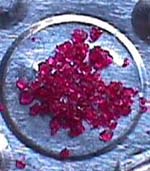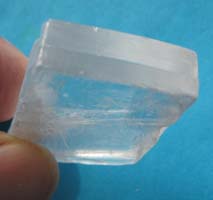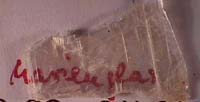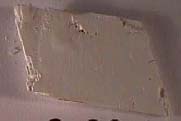-k.jpg) .
. .
. .
. .
.
salt12 Water of crystallisation in gypsum and
salts of cobalt
 You have already done experiments
with red cobalt chloride.
You have already done experiments
with red cobalt chloride.
 A lamp shade
of alabaster (Photo 1), desert roses (Photo 2) and glassy gypsum (Photo
3 and 4) are calcium salts of sulfuric acid with a specific quantity
of water in a chemical bond (crystal water).
A lamp shade
of alabaster (Photo 1), desert roses (Photo 2) and glassy gypsum (Photo
3 and 4) are calcium salts of sulfuric acid with a specific quantity
of water in a chemical bond (crystal water).
In the following experiment a small quantity of "Marienglas" is weighed
and heated in an ampoule until no more water appears. After cooling the product
(Photo 5) is re-weighed.
What you need
2 Liquemin
bottles, micro spirit burner, clothes peg to hold the bottle, some crystals
of red cobalt chloride, a piece of glassy gypsum ("Marienglas").
Photo 4: Glassy gypsum
allows to read the word "Marienglas" through it. Heat it in a horizontal bottle.
Observation
Photo 5: The glassy gypsum is not longer
transparent and has a white colour, water vapour escapes.
Explanation
Red cobalt chloride is not
only made of cobalt ions and chloride ions. Its crystals also contain water
molecules bonded to the ions (crystal water).
Glassy gypsum also contains crystal water. During heating crystal water is
split off, the new substances blue cobalt chloride and white gypsum are formed:
CoCl2.6H2O
----------------------------> CoCl2
+
6 H2O
red cobalt chloride
with crystal water blue cobalt
chloride without crystal water
water
CaSO4.2 H2O --------------------------->
(CaSO4)
+
2 H2O
glassy calcium sulfate
with crystal water white calcium sulfate without
crystal water water
back........first published: 25.10.2001............last modification: 06.03.2007
-k.jpg) .
. .
.